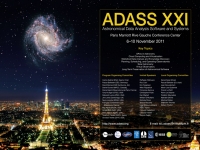Alexis Tejeda (ESO/ALMA), Dominique Broguiere (IRAM), Robert Lucas (ESO/ALMA), Jean-Christophe Roche (IRAM)
Abstract
The Atacama Large Millimeter Array (ALMA) is a radio interferometer of 50 antennas for astronomy observation purposes that is under construction at the Chajnantor plateau at 5000 meters altitude in the Atacama desert in northern Chile. The data calibration is done by Telescope Calibration software (TELCAL) which is a subsystem of the ALMA software. The data calibration consists of several calculations and processes that are performed in order to ensure that ALMA is and remains in proper shape to successfully observe the projects as they are scheduled. ALMA being a radio astronomy observatory, the daylight can't affect the observations, therefore every single calibration data calculation must happen at regular intervals, typically 20 minutes, consuming valuable observation time. ALMA requirement for calibration of the 50 antennas is to be done in the 0.5 seconds following the reception of the data while the antennas are moving to the next source.
Most of the performance problems laid on external libraries and functions loops with memory references, a re-coding and an interprocedural optimization among the external libraries and TELCAL were necessary to do a statistical and measurement analysis of the calibration calculations (avoiding I/O operations time) using different combinations of libraries, compilers and compiler flags identifying the time-consuming portions of code, functions, modules and libraries. The analysis showed improvements after the optimization with a standard deviation average of 2.31 seconds, with an input data of 17 antennas.
Currently ALMA has 20 antennas in operation and 50 antennas to be used in the near future. Undoubtedly the software will have a different behavior than now, generating considerable dead observation time while the calibration calculations are done. For this reason it is necessary to apply the work done for optimization of the performance returning the calibration results in the shortest possible time using using all currently available technological resources to reach the requirements.Paper ID: P152
Poster Instructions
|

